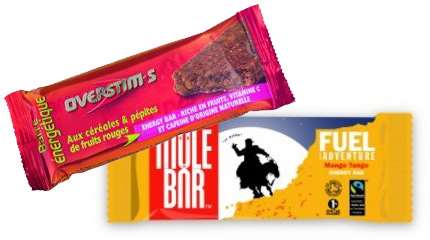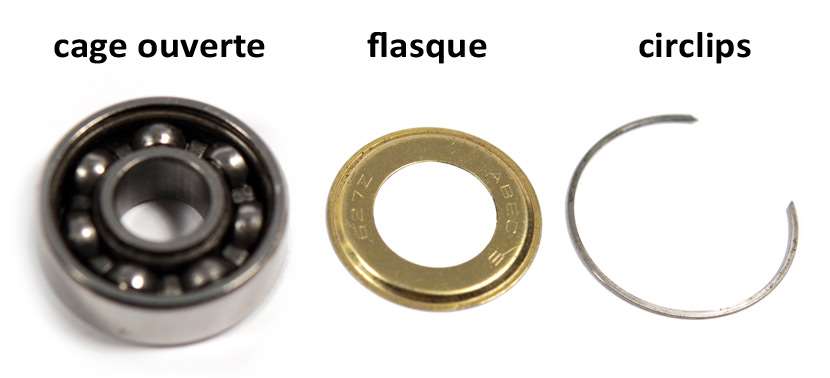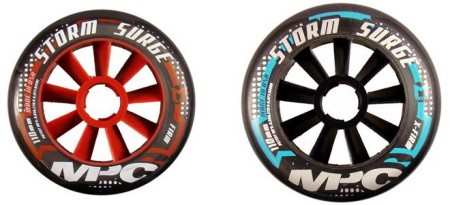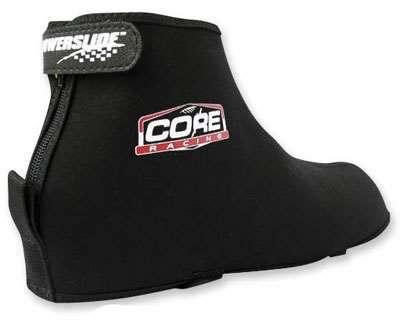Tips to skate in the winter-time
Winter has come, with its rain and its biting cold. Skating is at the mercy of bad weather. Here are a few solutions in order to skate in the winter-time with total peace of mind...
Par alfathor

Equipment, clothing, training…
Equipment is strongly exposed to weather conditions, especially bearings, which suffer from the assaults of mud. Let’s not neglect to protect our skate boots too.
Bearings: Opt for grease rather than oil
 The combination of water and dirt is perfect for bearing deterioration. All it takes for a bearing to start oxidizing is a thin layer of water on its outside.
The combination of water and dirt is perfect for bearing deterioration. All it takes for a bearing to start oxidizing is a thin layer of water on its outside.
Lubricating bearings with oil or gel makes them less resistant to water. If you happen to skate in a puddle, water is going to infiltrate between the flanges and flood the cage containing the balls. If you store the bearings without drying/cleaning them, they will rust irreparably.
Opt for grease, more viscous and hydrophobic than oil. It stays better inside the cages. Greased bearings are less performant than oil bearings but they resist far better to moist.
What about ceramic bearings?
There is one thing you should know about ceramic skate bearings: Most of the time, only the balls are made of ceramic. Which means that the cage of the ceramic bearing can rust just as well as a classic bearing if it is made of chrome steel. Ceramic bearings are less sensitive but not eternal either. If the bearing contains stainless steel, it will put up better with bad weather. On the other hand the set is far more expensive.
 According to us, not to ruin yourself, better choose bearings with elastomers flanges (better water resistance than the 608ZZ’s with metal flanges). They don’t require much cleaning.
According to us, not to ruin yourself, better choose bearings with elastomers flanges (better water resistance than the 608ZZ’s with metal flanges). They don’t require much cleaning.
Wheels: Rain tires?
Cold has an impact on the wheel’s polyurethane and makes it harder. Set up softer wheels than for summer time in order to keep a good grip.
There are special wheels for damp and slippery surfaces too. They offer a far better grip in the rain and water. The best-known wheels of the range are the MPC Storm Surge, a reference model at the highest world level. They are expensive but of great quality.
On the other hand, on dry surfaces, rain wheels stick too much on the road. We would advise you to always have two sets of wheels with you according to the weather conditions.
Taking care of your skate boots
 After a rainy outing, and even in a more general way, skate boots/shoes should not be stored away in a plastic bag. They could make moldy. Leave them in a dry and aired place. If they are soaking wet, stuff them with newspaper to absorb the water. Don’t forget to take off the insoles to speed up the drying. Regularly change the paper during the first hours. Last but not least, don’t hesitate to wipe the frames with a rag to take off the dirt.
After a rainy outing, and even in a more general way, skate boots/shoes should not be stored away in a plastic bag. They could make moldy. Leave them in a dry and aired place. If they are soaking wet, stuff them with newspaper to absorb the water. Don’t forget to take off the insoles to speed up the drying. Regularly change the paper during the first hours. Last but not least, don’t hesitate to wipe the frames with a rag to take off the dirt.
Boot covers: Handy!
Leather and carbon boots don’t get on very well with water. Manufacturers have designed boot covers to protect them. Opt for a model with a waterproof fabric or made of neoprene for less humidity and cold.
Some boot covers for fitness skates also exists, with a higher ankle cut.
Clothing
Breathable fabrics
Big brands today offer products favoring sweat evacuation. They can also serve as windbreakers. The problem with raincoats is that they tend to keep the moisture in. Clothes turn into a sauna, your body is wet, which accentuates the feeling of cold. In order for those technologies to be efficient, you shouldn’t put too many layers of clothing on.
Taking layers off bit by bit
While warming up, your body needs to keep warm. That is why you should be adequately covered up at the beginning of your session. As you go along, and once you got started, the heat produced by the effort reduces the effect of cold. You can then get rid of some of your clothes to evacuate the sweat. Otherwise it will accentuate the effect of cold. You have to find the good balance. As soon as you make a break, don’t wait until you are cold to cover yourself up.
Be visible and see at night
 Days are shorter in winter. You often train in the dark, in the morning or in the evening, for want of fully lighted routes. So that, for your own safety and that of others, it is better to wear a few accessories, like luminous devices: armbands, headlamp, retro-reflective safety jacket… even
Days are shorter in winter. You often train in the dark, in the morning or in the evening, for want of fully lighted routes. So that, for your own safety and that of others, it is better to wear a few accessories, like luminous devices: armbands, headlamp, retro-reflective safety jacket… even
wheels equipped with LED lights?
Training
Start gradually
In the summer time you can allow yourself to start stronger and faster. It is a whole other story when temperatures flirt with zero! Muscles are numb, contracted, and risks of pulling, straining or tearing a muscle are higher. The warm-up phase should be gradual. You body needs a minimum of preparation before running at full capacity.
Count at least 20 to 30 min before starting high intensity drills. If you want to stretch, find a place sheltered from the wind, or a heated place, not to cool down before the beginning of the session.
Shorten the breaks
 Your body cools down during moments of calm and recovery. We would advise you to recover more actively than usually, staying in motion at a lower intensity. Static recovery is not recommended: Your body cools down and the acids produced during effort are not evacuated. All in all, don’t sit down and wait.
Your body cools down during moments of calm and recovery. We would advise you to recover more actively than usually, staying in motion at a lower intensity. Static recovery is not recommended: Your body cools down and the acids produced during effort are not evacuated. All in all, don’t sit down and wait.
Eat and hydrate yourself
Your body needs a lot of energy to keep a constant temperature when it is cold. A few cereal bars will be welcome during long sessions in order to compensate for that additional energy expense. Do not forget to drink too. As the cyclists say: Eat before you are hungry and drink before you are thirsty to avoid attacks of exhaustion.
Training indoors?
Even if the idea is not alway attractive for great outdoors lovers, training indoors still has some advantages. First of all, the quality of the place is constant, the temperature doesn’t vary much, the surface is normally dry, and drafts are rare. It might also be the opportunity to work on your technique, especially in bends. Indoor and narrow spaces imply very specific skating attention as for edge taking.
Varying your sports activities
Last but not least, if you object to skating in the rain, nobody will hold it against you. There are many complementary disciplines that can be integrated into your skate training. In Elite for example, cycle trainings often alternate with skate sessions. A recovery or endurance outing with cyclists will easily replace a few hours of skating. Jogging is also a good complement for a skate preparation. In Canada, skaters complete their training with ice skating sessions. Do not hesitate to ask your coach or to go to a club!
Links
The maintenance of your skate frame
How to clean and take care of your bearings?
Precautions to take while skating by cold weather
Translation: Chloe Seyres
Photos: ReL and all rights reserved
